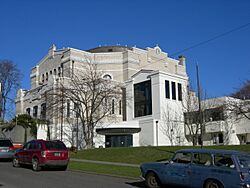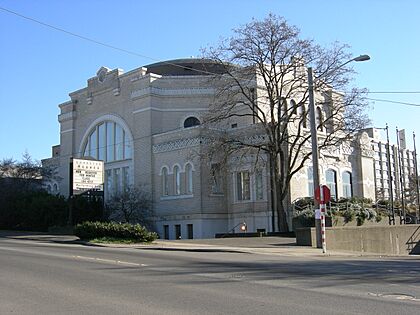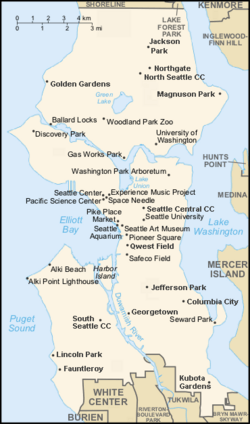Langston Hughes Performing Arts Institute facts for kids

Langston Hughes Performing Arts Institute, viewed by the southwest, in 2007
|
|
| Former names |
|
|---|---|
| Address | 104 17th Avenue South Central District Seattle, Washington 98144 United States |
| Coordinates | 47°36′05″N 122°18′36″W / 47.60139°N 122.31000°W |
| Owner | LANGSTON Seattle |
| Type | Theater; Arts center |
| Genre(s) | African American art, artists, and audiences |
| Chevra Bikur Cholim | |
|---|---|

The former synagogue
|
|
| Religion | |
| Affiliation | Orthodox Judaism (former) |
| Ecclesiastical or organizational status | Synagogue (1915 – 1969) |
| Status | Closed and deconsecrated |
| Location | |
| Location | 104 17th Avenue South, Central District Seattle, Washington |
| Architecture | |
| Architect(s) | B. Marcus Priteca |
| Architectural type | Synagogue |
| Architectural style | Byzantine Revival |
| Completed | 1915 |
The Langston Hughes Performing Arts Institute is a special place in Seattle, Washington. It's a cultural center that celebrates African American art and artists. The center is located at 104 17th Avenue South, in the Central District. A non-profit group called LANGSTON Seattle owns and runs it.
This building was first built in 1915 as a synagogue, a Jewish house of worship. A famous architect named Marcus Priteca designed it. In 1969, the Jewish community sold the building to the City of Seattle. After some updates, it became an arts center. The center is named after Langston Hughes, a very important writer from the Harlem Renaissance. The building is also recognized as a Seattle landmark.
Over the years, the building has had a few different names. These include the Yesler-Atlantic Community Center, the Langston Hughes Cultural Center, and the Langston Hughes Cultural Arts Center.
Contents
History of the Building
From Synagogue to Arts Center
The building was finished in 1915. It was designed in the Byzantine Revival style. This style uses elements from old Byzantine buildings. Architect B. Marcus Priteca created the plans for the Chevra Bikur Cholim, an Orthodox Jewish group. The synagogue officially opened in August 1915.
Priteca was a well-known architect. He designed many theaters across the United States. The lower part of an addition on the south side of the building was built in 1961. The upper part was added in 1971.
In 1969, the Jewish community sold the building to the City of Seattle. It became part of the Parks and Recreation department in 1972. The inside of the main hall was updated in 1971. A balcony was removed to make the seating area larger. More additions were made in 1991 and 2003. These new parts added offices and made the building easier for everyone to access.
How the Center Started
A Hub for Arts and Community
The Langston Hughes Performing Arts Center began in 1969. The city bought the building in 1971. The idea was to create Seattle's first African-American theater, Black Arts/West. They also planned a film training center for minority artists. However, the renovations took a long time. So, those groups found other places to go.
Even so, the institute became a very important place for Seattle's hip hop music scene. It also played a similar role for local African American actors and performers.
Balancing Art and Community Needs
For many years, the center had two main goals. It was a community center for local kids and families. It was also a serious arts organization. Here, talented actors, dancers, and poets could perform and train.
Because the city funded the center, it didn't have to worry about paying rent. However, this also meant the city had a say in its programs. Sometimes, this meant focusing on arts and crafts rather than high-quality performances.
In 2001, the Parks and Recreation department asked the institute to focus more on high-quality arts. Jacqueline Moscou became the artistic director. In 2004, she started a program to train young actors. Some people worried that the center might lose its friendly, neighborhood feel. They also worried that its focus on African-American culture might become less strong.
In 2007, there was a disagreement involving Jacqueline Moscou and some colleagues. After many people spoke up, she returned to her role in March 2008. The center continued its work supporting African American art and artists.


